
Empress
The Astonishing Reign of Nur Jahan
کتاب های مرتبط
- اطلاعات
- نقد و بررسی
- دیدگاه کاربران
نقد و بررسی

April 16, 2018
In this feminist biography of a strong and independent Muslim woman who, over the intervening centuries, has been reduced to a caricature of wifely devotion in the popular imagination, Lal makes clear her subject’s relevance. Lal, a history professor at Emory, goes far beyond the fables to demonstrate that Nur Jahan was a force to be reckoned with: she ruled jointly as co-sovereign of the Mughal Empire with her husband, the emperor Jahangir, from their marriage in 1611 and was recognized by foreign and domestic observers as the true power in the realm. The women of the royal household, including Jahangir’s 19 other wives, spent most of their lives sequestered, but “the harem offered women surprising opportunities—wide horizons behind high walls.” Jahangir was an aesthete who concerned himself primarily with “the grand ritual acts of ideal Mughal kingship,” such as “offering his subjects glimpses of his semi-divine person from the imperial balcony.” Meanwhile, it was Nur Jahan who commissioned palaces and gardens, issued royal edicts and minted currency, and even defended the realm from usurpers, “sitting atop a war elephant and armed with a musket.” Closely researched and vividly written, this telling finds that the truth is as fantastic and fascinating as myth.

May 15, 2018
Born to Persian nobility traveling to the Mughal empire, Nur Jahan (1577-1645) survived an uncertain birth and childhood to go on to hunt tigers, lead men in battle, and wield power and influence at a level almost unheard of for a Muslim woman of that time, reigning over India with her husband, the emperor Jahangir, from 1614 to 1627. Lal's (South Asian history, Emory Univ.; Domesticity and Power in the Early Mughal World) examination of Jahan's life attempts to look beyond slanted historical opinions, legends, and fiction to form a more balanced viewpoint of her life. And while that resulting portrait still contains gaps--little record remains, for example, of Jahan's early life, and none of exactly how she rose so quickly and so high from the ranks of Jahangir's other wives--the author makes use of the absences to explore the upbringing of girls and the responsibilities of royal wives in the Mughal empire in general. VERDICT More a narrative history than full biography, Lal's work nevertheless provides a vivid look at her subject and the world in which she lived. An excellent choice for popular history readers interested in women rulers.--Kathleen McCallister, Tulane Univ., New Orleans
Copyright 2018 Library Journal, LLC Used with permission.

Starred review from May 1, 2018
Lal (South Asian History/Emory Univ.; Coming of Age in Nineteenth-Century India: The Girl-Child and the Art of Playfulness, 2013, etc.) shines a light on Nur Jahan (1577-1645), who ruled as co-sovereign in the Mughal court, taking her husband's place without actually usurping him.Before she ascended, her husband, Jahangir, had fallen victim to overindulgence in drink and opium, and she slowly assumed duties with his full support. Jahangir was mercurial, ill-tempered, but he loved the signs of royal power. His traveling procession consisted of hundreds of tents draped in velvet and brocade, an audience hall of more than 70 rooms with 1,000 carpets, a harem, and stables. He inherited none of his father's empire-building drive, but he was a patron of the arts, hunter, naturalist, mystic, and book lover. He loved statistics and traveled mainly to make measurements of flora and fauna and catalog the characteristics of his country. He saw his wife as highly intelligent, talented, and politically savvy, which was due in large part to an aristocratic upbringing in her Persian parents' household. Rather than serving as a quiet counselor and smoothing relations between the emperor and his sons, Nur took direct action. She was an accomplished adviser, hunter, diplomat, and aesthete. She designed her parents' tomb in Agra, anticipating the Taj Mahal, which was built by her stepson, Shah Jahan. Agra was also home to her designs for her and Jahangir's tombs and her famous Light Scattering Garden. The author's descriptions of Agra are superb, and her detailed explanations of Nur's upbringing reflect her long study, deep understanding, and modern take on a little-explored subject. When the emperor was kidnapped by his son's ally, it was Nur who led an army to attempt his rescue. She must be held as one of history's great independent, powerful women.A page-turning, eye-opening biography that shatters our impressions of India as established by the British Raj.
COPYRIGHT(2018) Kirkus Reviews, ALL RIGHTS RESERVED.

























دیدگاه کاربران